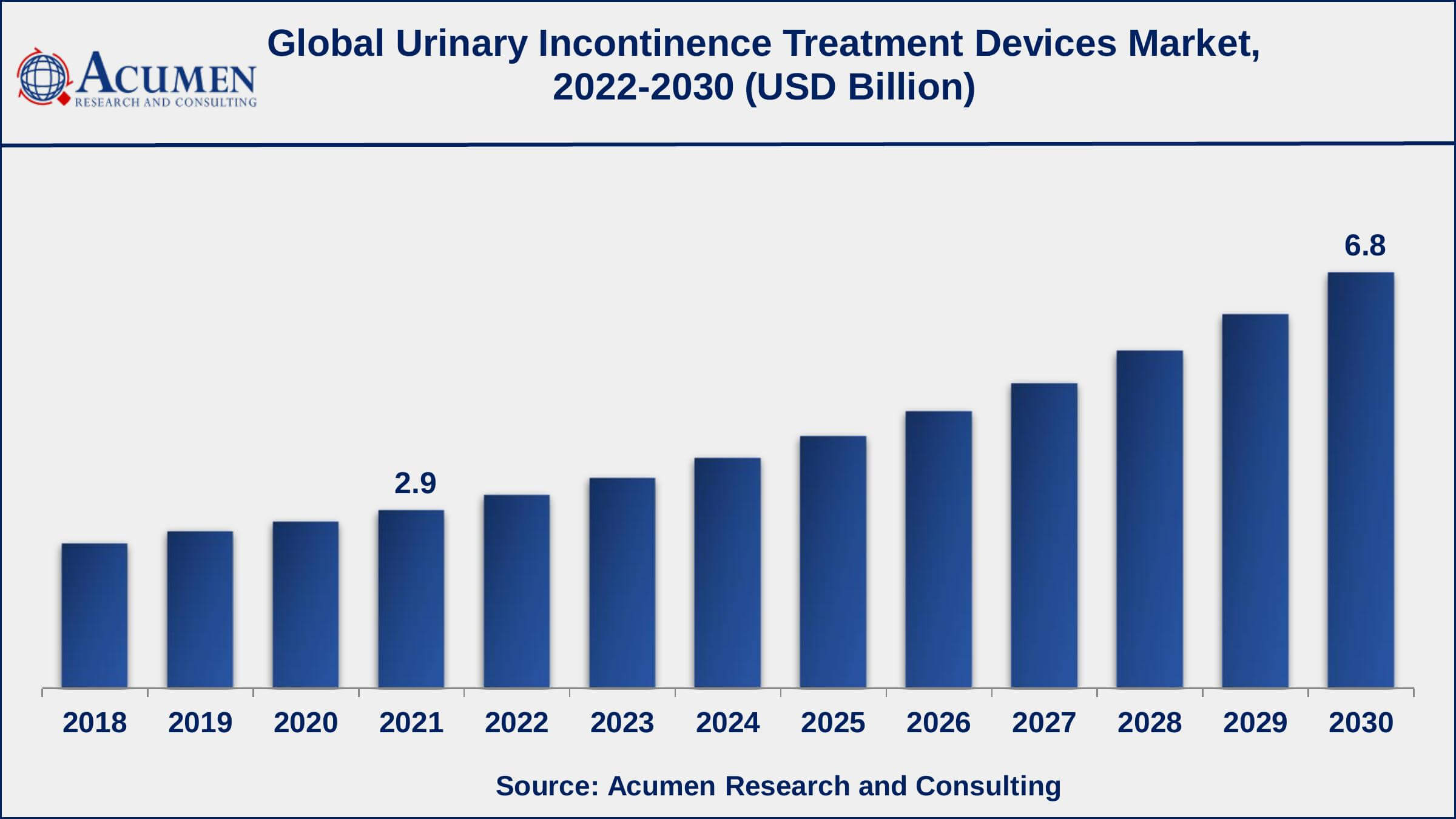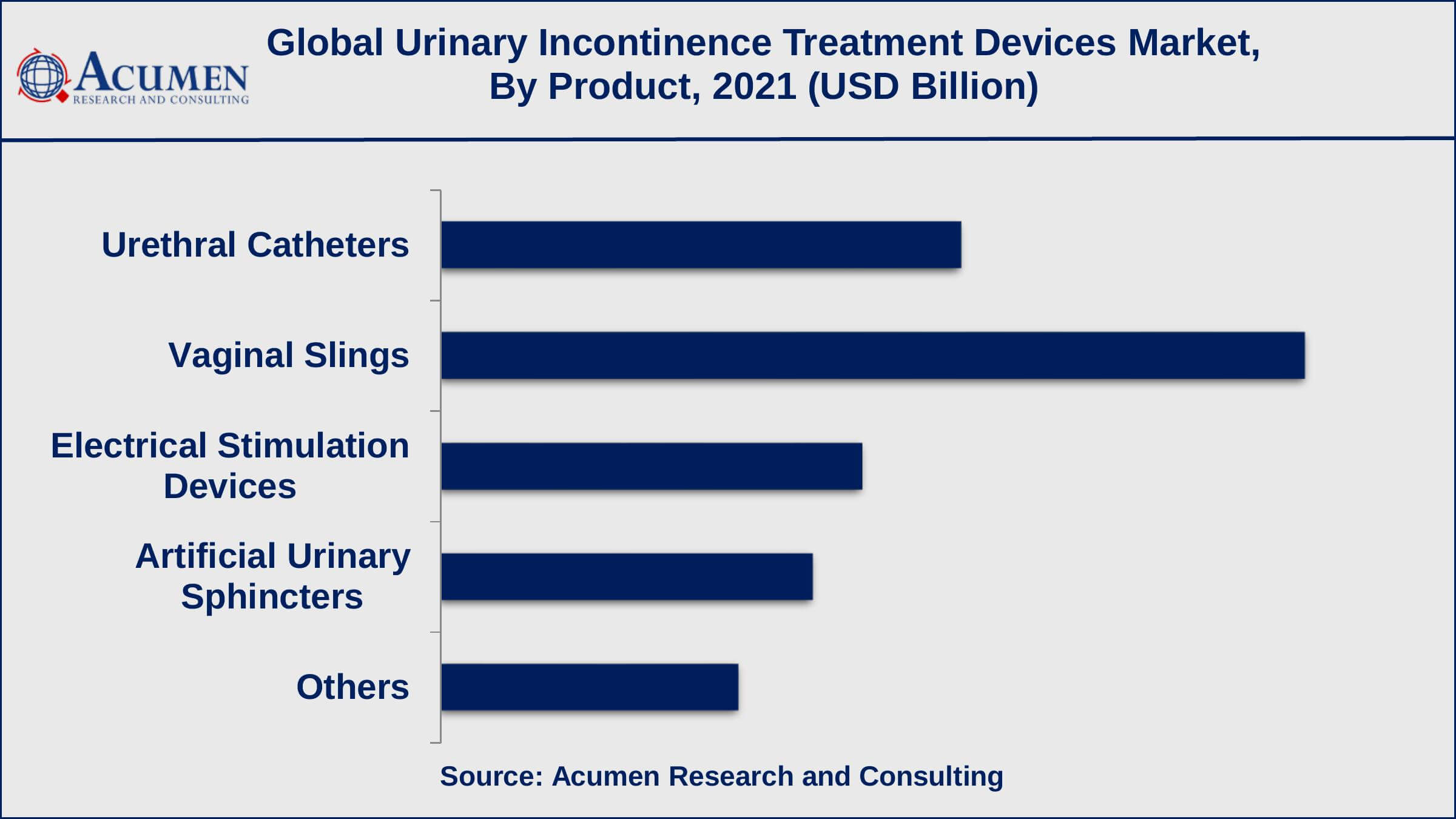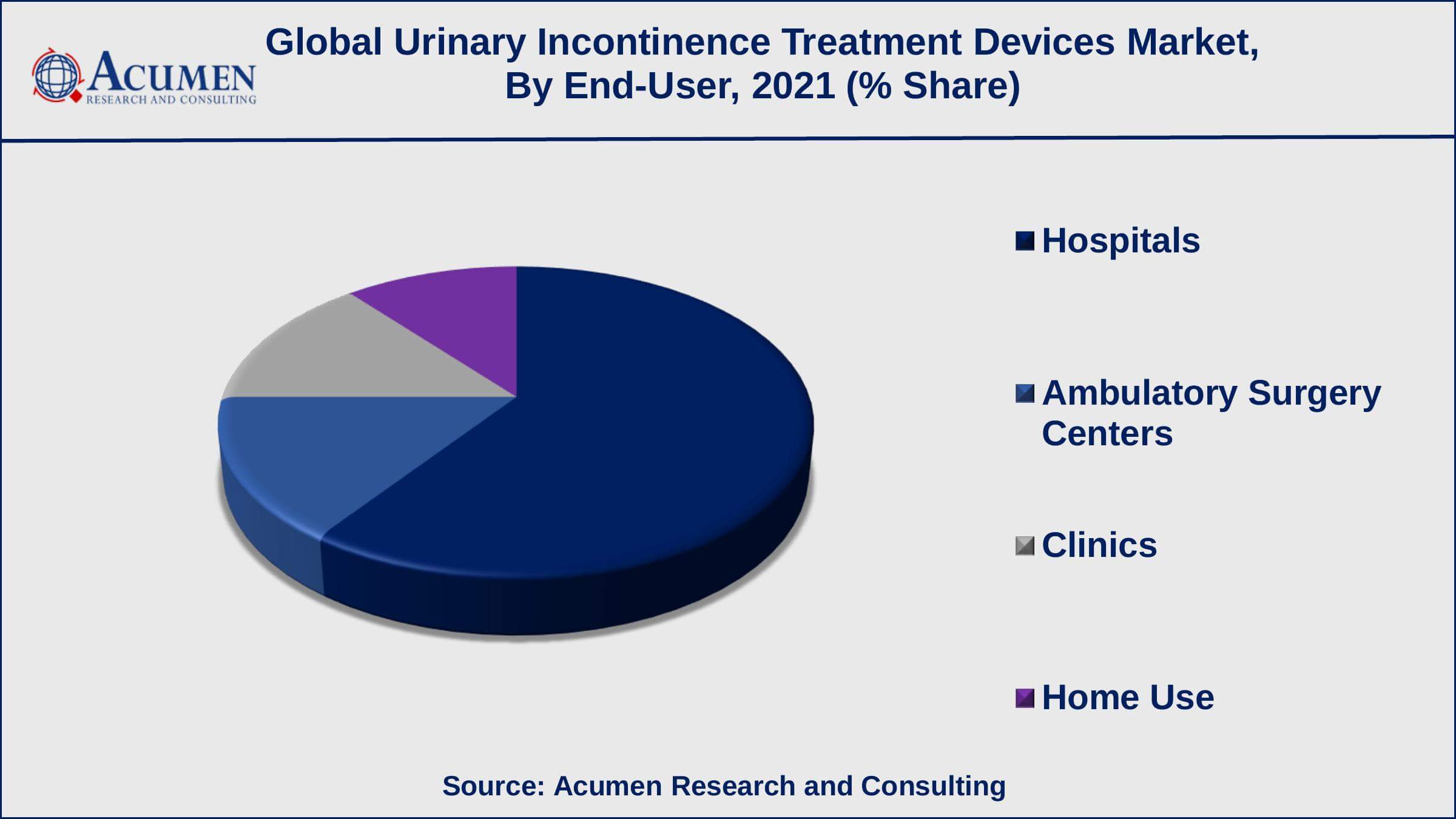Urinary Incontinence Treatment Devices Market Size - Global Industry, Share, Analysis, Trends and Forecast 2022 - 2030
Published :
Report ID:
Pages :
Format :
Urinary Incontinence Treatment Devices Market Size - Global Industry, Share, Analysis, Trends and Forecast 2022 - 2030
Report Coverage
- Industry Dynamics
- Market Size and Forecast Data
- Segment Analysis
- Competitive Landscape
- Regional Analysis with a Niche Focus on Country-Level Data
- High Level Analysis - Porter's, PESTEL, Value Chain, etc.
- Company Profiles of Key Players
- Option to Customize the Report As Per Your Specific Need
Request Sample Report
The Global Urinary Incontinence Treatment Devices Market Size accounted for USD 2.9 Billion in 2021 and is projected to occupy a market size of USD 6.8 Billion by 2030 growing at a CAGR of 10.1% from 2022 to 2030.
Urinary incontinence is a very common condition that causes people to lose urine involuntarily. Urinary incontinence, also known as overactive bladder, is more common in the elderly population, particularly women. According to the National Association for Incontinence, more than 200 million people worldwide suffer from urinary incontinence. The study also found that UT is twice as common in women as it is in men. For example, according to Office on Women’s Health (OASH) approximately 23% of women over the age of 60 suffer from incontinence. Furthermore, approximately 24% of women between age 18 and 44 experience incontinence.

Urinary Incontinence Treatment Devices Market Report Statistics
- Global urinary incontinence treatment devices market revenue is projected to reach USD 6.8 Billion by 2030 with a CAGR of 10.1% from 2022 to 2030
- North America urinary incontinence treatment devices market share generated over 43% shares in 2021
- As per the National Association for Incontinence organization, more than 25 million adult Americans suffer from incontinence
- Asia-Pacific urinary incontinence treatment devices market growth will register impressive CAGR from 2022 to 2030
- Based on product, vaginal slings recorded over 34% of the overall market share in 2021
- Among end-user, hospitals sector generated shares of over 60% in 2021
- Rising adoption of electrical stimulation devices is a popular urinary incontinence treatment devices market trend that fuels the industry demand

Global Urinary Incontinence Treatment Devices Market Dynamics
Market Drivers
- Rising incidences of urinary incontinence and overactive bladder
- Growth in elderly population across the world
- Surging cases of prostate cancer
- Increase in shift from conventional to advanced urinary incontinent products
Market Restraints
- Lack of awareness regarding these devices
- Post-operative complications and high cost of treatment
Market Opportunities
- Favorable reimbursement policies
- Rising research & development by key players to launch new products
Urinary Incontinence Treatment Devices Market Report Coverage
| Market | Urinary Incontinence Treatment Devices Market |
| Urinary Incontinence Treatment Devices Market Size 2021 | USD 2.9 Billion |
| Urinary Incontinence Treatment Devices Market Forecast 2030 | USD 6.8 Billion |
| Urinary Incontinence Treatment Devices Market CAGR During 2022 - 2030 | 10.1% |
| Urinary Incontinence Treatment Devices Market Analysis Period | 2018 - 2030 |
| Urinary Incontinence Treatment Devices Market Base Year | 2021 |
| Urinary Incontinence Treatment Devices Market Forecast Data | 2022 - 2030 |
| Segments Covered | By Product, By Incontinence Type, By End-User, And By Geography |
| Regional Scope | North America, Europe, Asia Pacific, Latin America, and Middle East & Africa |
| Key Companies Profiled | Teleflex Incorporated, Boston Scientific Corporation, A.M.I. GmbH, C. R. Bard, Inc., B. Braun Melsungen AG, Coloplast Group, Atlantic Therapeutics Group Ltd., Promedon Group, Hollister Incorporated, Medtronic plc, InControl Medical LLC, Ethicon US, LLC. and ZSI Surgical Implants S.R.L. |
| Report Coverage |
Market Trends, Drivers, Restraints, Competitive Analysis, Player Profiling, Regulation Analysis |
Urinary Incontinence Treatment Devices Market Growth Factors
High development of the market is credited to increment in reception, simple accessibility of electrical vaginal incitement, and ascend sought after for minimally invasive or non-surgical products over the globe.
Urinary incontinence is characterized as involuntary release of urinary because of loss of bladder control. A huge number of individuals over the world are influenced by urinary incontinence and ladies are bound to be influenced than men. Urinary incontinence is profoundly under reported essentially because of shame to talk about it. More than 500 million individuals over the globe are influenced by the condition and its occurrence increments with age. A few factors, for example, urinary tract disease, debilitating of pelvic floor muscles and urethral sphincters, menopause, pregnancy and childbirth, and post radical prostatectomy medical surgery in men lead to the improvement of urinary incontinence side effects.
Urinary Incontinence Treatment Devices Market Segmentation
The global urinary incontinence treatment devices market is segmented based on product, incontinence type, end-user, and geography.
Urinary Incontinence Treatment Devices Market By Product
- Urethral Catheters
- Foley Catheters
- Other Urinary Catheters
- Vaginal Slings
- Advanced Vaginal Slings
- Conventional Vaginal Slings
- Electrical Stimulation Devices
- Artificial Urinary Sphincters
- Others

According to the urinary incontinence treatment devices industry analysis, vaginal slings sub-segment achieved significant market share in 2021 and is likely to continue its trend during the forecast timeframe from 2022 to 2030. Advances in conventional vaginal slings aid in the elimination of post-operative complications associated with vaginal sling surgeries, and several key players are evolving conventional vaginal slings using sophisticated synthetic materials to meet the patient's needs.
Urinary Incontinence Treatment Devices Market By Incontinence Type
- Stress Urinary Incontinence
- Urge Urinary Incontinence
- Mixed Incontinence
- Overflow Incontinence
As far as incontinence type, the urge incontinence fragment is anticipated to overwhelm the worldwide urinary incontinence treatment market during the forecast period. The segment is foreseen to extend at a high CAGR from 2022 to 2030. A great many individuals over the globe are influenced by overactive bladder that prompts encourage incontinence. Strength of the urge incontinence section is attributed to greater expense of treatment gadgets, particularly implantable electrical stimulation gadgets, than other treatment gadgets/strategies. In this way, increment in rate of urge incontinence, ascend in selection of electrical stimulation gadgets for overactive bladder treatment, and new product dispatches in the section are relied upon to add to the development of the segment amid the coming years.
Urinary Incontinence Treatment Devices Market By End-User
- Hospitals
- Ambulatory Surgery Centers
- Clinics
- Home Use

According to the urinary incontinence treatment devices market forecast, the hospitals is expected to occupy a notable market share during 2022 to 2030. The segment is experiencing rapid growth as a large patient pool struggling from chronic conditions or pregnancy is associated with urinary incontinence. The increase in the number of medical procedures for the treatment of all kinds of urinary incontinence, as well as favorable reimbursement policies for medical devices in most developed and developing countries can be attributed to the segment's growth.
Urinary Incontinence Treatment Devices Market Regional Outlook
North America
- U.S.
- Canada
Europe
- U.K.
- Germany
- France
- Spain
- Rest of Europe
Asia-Pacific
- India
- Japan
- China
- Australia
- South Korea
- Rest of Asia-Pacific
Latin America
- Brazil
- Mexico
- Rest of Latin America
The Middle East & Africa
- South Africa
- GCC Countries
- Rest of the Middle East & Africa (ME&A)
Urinary Incontinence Treatment Devices Market Regional Analysis
Geologically, the worldwide urinary incontinence treatment gadgets market has been portioned into five noteworthy areas: North America, Asia Pacific, Europe, Latin America, and Middle East & Africa. North America represented the biggest offer of the worldwide market in 2021, followed by Europe. Developed health care facilities, favorable reimbursement policies, and early appropriation of innovatively propelled products for the administration of urinary incontinence have added to North America's substantial share of the overall industry.
Asia-Pacific is probably going to account market share of the overall industry by 2030. This is because of expansive urinary incontinence quiet base in exceedingly populated nations, for example, India and China, substantial geriatric populace in Japan, and ascends in selection of innovatively propelled products in Japan, Australia, New Zealand, and South Korea. Ascend in appropriation of innovatively propelled products by key producers, for example, Boston Scientific Corporation, Medtronic plc, and Cogentix Medical is probably going to impel the worldwide urinary incontinence treatment gadgets market. The market in Europe is required to grow at the most elevated CAGR of 10.5% from 2022 to 2030.
As far as incontinence type, the urge incontinence fragment is anticipated to overwhelm the worldwide urinary incontinence treatment market during the forecast period. The segment is foreseen to extend at a high CAGR from 2022 to 2030. A great many individuals over the globe are influenced by overactive bladder that prompts encourage incontinence. Strength of the urge incontinence section is attributed to greater expense of treatment gadgets, particularly implantable electrical stimulation gadgets, than other treatment gadgets/strategies. In this way, increment in rate of urge incontinence, ascend in selection of electrical stimulation gadgets for overactive bladder treatment, and new product dispatches in the section are relied upon to add to the development of the segment amid the coming years.
Urinary Incontinence Treatment Devices Market Players
Substantial companies working in the global urinary incontinence treatment devices market are Teleflex Incorporated, Boston Scientific Corporation, A.M.I. GmbH, C. R. Bard, Inc., B. Braun Melsungen AG, Coloplast Group, Atlantic Therapeutics Group Ltd., Promedon Group, Hollister Incorporated, Medtronic plc, InControl Medical LLC, Ethicon US, LLC. and ZSI Surgical Implants S.R.L.
Frequently Asked Questions
What is the size of global urinary incontinence treatment devices market in 2021?
The market size of urinary incontinence treatment devices market in 2021 was accounted to be USD 2.9 Billion.
What is the CAGR of global urinary incontinence treatment devices market during forecast period of 2022 to 2030?
The projected CAGR of urinary incontinence treatment devices market during the analysis period of 2022 to 2030 is 10.1%.
Which are the key players operating in the market?
The prominent players of the global urinary incontinence treatment devices market include Teleflex Incorporated, Boston Scientific Corporation, A.M.I. GmbH, C. R. Bard, Inc., B. Braun Melsungen AG, Coloplast Group, Atlantic Therapeutics Group Ltd., Promedon Group, Hollister Incorporated, Medtronic plc, InControl Medical LLC, Ethicon US, LLC. and ZSI Surgical Implants S.R.L..
Which region held the dominating position in the global urinary incontinence treatment devices market?
North America held the dominating urinary incontinence treatment devices during the analysis period of 2022 to 2030.
Which region registered the fastest growing CAGR for the forecast period of 2022 to 2030?
Asia-Pacific region exhibited fastest growing CAGR for urinary incontinence treatment devices during the analysis period of 2022 to 2030.
What are the current trends and dynamics in the global urinary incontinence treatment devices market?
Rising incidences of urinary incontinence and overactive bladder, growth in elderly population across the world, and surging cases of prostate cancer drives the growth of global urinary incontinence treatment devices market.
Which incontinence type held the maximum share in 2021?
Based on incontinence type, urge urinary incontinence segment is expected to hold the maximum share of the urinary incontinence treatment devices market.



